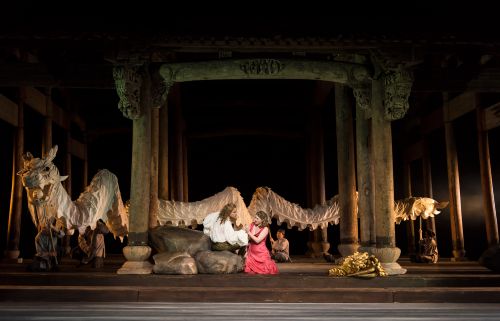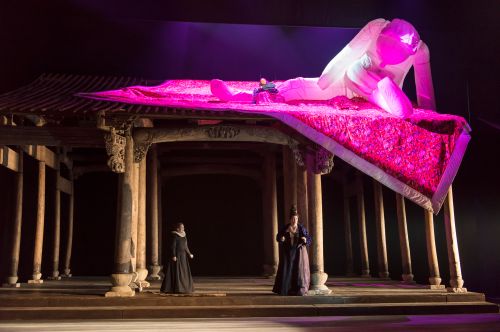Handel: Semele, Canadian Opera Company, Christopher Moulds (conductor), Brooklyn Academy of Music, Brooklyn, New York, 4.3.2015 (SM)

Photo Credit: Jack Vartoogian/Frontrowphotos
Cast:
Cadmus/Somnus: Kyle Ketelsen
Athamas: Lawrence Zazzo
Semele: Jane Archibald
Ino/Juno: Hilary Summers
Iris: Katherine Whyte
Jupiter: Colin Ainsworth
Production:
Director: Zhang Huan
Sets: Zhang Huan
Costumes: Han Feng
Original lighting: Wolfgang Gőbbel
Lighting recreated by Willem Laarman
What do a 17-ton, 450-year-old Chinese temple; a film about its history and deconstruction; a donkey with a very strong libido and an instrument that proves it; Buddhist monks with a penchant for what Norman O. Brown called “polymorphous perversity”; a Tibetan throat singer; two 350-pound sumo wrestlers who engage in a real fight; a huge bed atop a corner of the temple roof upon which a mammoth blow-up doll droops; a sinuous Chinese dragon puppet; and, yes, a funeral procession in which mourners hum “The Internationale” have in common?
They are all part of the production of Handel’s oratorio/opera Semele taking place at the Brooklyn Academy of Music. BAM has never been the Metropolitan Opera, and happily it continues the high standard of presenting new and controversial events. (Just look at the Met season for 2015-2016: two 20th-century “modern” operas ̶ Lulu and Elektra ̶ and none, not one, that predates Mozart.) Stagings of Baroque opera and dance over the years have always been imaginative and often provocative re-creations, so I doubt there was much shocking of the bourgeoisie here. The copulating rabbits in Purcell’s The Fairy Queen took the edge off any orgies emulated in Semele.
This mixed media production is directed by Zhang Huan, a controversial performance artist in his first foray into opera. He recently commented about how he felt a strong connection with Semele and its dramatic (operatic) possibilities, and as odd and off-beat as the staging was, it worked. Why? For one thing, there are no directions given in the libretto as to how it should be staged. According to Christopher Hogwood, Handel stated that Semele was “written after the manner of an oratorio,” and it was originally performed in concert style with the chorus on stage and no acting. However, William Congreve, the librettist, thought he was writing for an opera, and the storyline is better suited for a dramatic presentation. No one can say that one staging has more authority than another since there is no standard against which to judge. This and other Baroque operas often have a feeling of being arbitrary: scenes appear that have little connection to the ongoing story. The scene here with Somnus, for example, may have been meant to serve as a comic interlude; but in Baroque opera, often anything goes.
Yet the performance, despite brilliant costumes and a striking set, was curiously lackluster. The quality of the music itself comes nowhere near Handel’s later oratorio, Theodora, which he considered his greatest work. It is possible that Handel shortchanged Semele by rushing it, completing the entire piece in about a month. It was the first work he was able to produce after recovering from a “palsy” that had prevented him from writing for several weeks. By comparison, Theodora took twice as long to complete.
Much of the humor was sophomoric or built on sexual activity, and the cast played up these actions. In most cases it was fine, but one of Handel’s greatest arias, “Where’er You Walk,” suffered from the distraction of pairs of chorus members faux-fornicating in the background. It’s hard to focus on the vocalist when soft-porn is going on.

Photo Credit: Jack Vartoogian/Frontrow
photos
The soloists were all good, with no real star outshining the others. The great countertenor Lawrence Zazzo had only a small number of arias to sing as Athamas, and he handled believably the requisite touching and groping that persisted throughout most of the opera. Although everyone sang well, particularly Jane Archibald as Semele and Hilary Summers as Ino, Semele’s sister, and Juno, I found Colin Ainsworth’s voice exceptionally warm and sweet, giving a positive spin to the role of Jupiter. This was a Jupiter made human, a believable person as opposed to the threatening, all-powerful Thunder-Thrower. The orchestra and conductor were adequate, but it would have added more color to the music and reduced some of the dullness of the many da capo arias if this had been a Baroque music band instead.
There was one major decision, mentioned in the playbill, that colored or rather darkened the whole performance. Zhang Huan has stated that he intentionally ends the play unhappily. I’ve complained elsewhere that the happy endings of many serious or tragic operas contradict the whole direction of where the piece was going. Zhang stops, logically, where he should: after the singers finish their lament for the dead Semele and hum “The Internationale.” Handel, on the other hand, closes with the Chorus singing :
Happy, happy shall we be,
Free from care, from sorrow free.
Guiltless pleasures we’ll enjoy,
Virtuous love will never cloy;
All that’s good and just we’ll prove,
And Bacchus crown the joys of love.
Not a very appropriate ending for a play whose heroine who has just been burned to death.
Stan Metzger